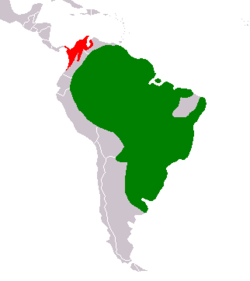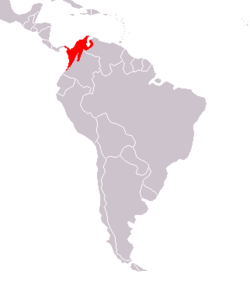Top Qs
Timeline
Chat
Perspective
Hydrochoerus
Genus of rodents From Wikipedia, the free encyclopedia
Remove ads
The genus Hydrochoerus contains two living and three extinct species of rodents from South America, the Caribbean island of Grenada, California and Panama.[1] Capybaras are the largest living rodents in the world. The genus name is derived from Ancient Greek ὕδωρ (húdor), meaning "water", and χοῖρος (khoîros), meaning "pig".
Remove ads
Characteristics
Capybaras are semiaquatic, found in and near lakes, rivers, swamps, and flooded savanna. Their diets are dominated by grasses. Adults weigh up to 65 kg (143 lb). The gestation period is 130–150 days, with two to eight (most commonly four) young born to females.
Behavior
Capybaras are highly social, living in groups of up to 100 and communicating through a variety of vocalizations.[2] Breeding is polygynous, with males forming harems.
Phylogeny and taxonomy
Summarize
Perspective
Molecular results have consistently suggested Hydrochoerus is most closely related to Kerodon (the rock cavies), and the two evolved from within the Caviidae.[2] This led Woods and Kilpatrick to unite the two into the subfamily Hydrochoerinae within the Caviidae.[1] Based on use of a molecular clock approach, Hydrochoerus appears to have diverged from Kerodon in the late Middle Miocene (about 12 million years ago).[3]
The extinct North American species formerly recognized as Hydrochoerus holmesi is now assigned to Neochoerus.[4]
Species
Extant Species
Fossils
- † Hydrochoerus ballesterensis – Pliocene capybara endemic to Argentina[5]
- † Hydrochoerus gaylordi – Plio-Pleistocene capybara endemic to the Caribbean island of Grenada[6][7]
- † Hydrochoerus hesperotiganites – Late Pleistocene capybara endemic to North America (San Diego County, California)[8]
Distribution
Presently, capybaras live in northern South America and adjacent southern Central America (lesser capybara) and in the tropical to subtropical regions of South America (capybara). The fossil species inhabited Buenos Aires Province in Argentina (H. ballesterensis) and the Caribbean island of Grenada (H. gaylordi). One species, H. hesperotiganites even ranged as far north as California.[8] Fossils of unspecified Hydrochoerus have been found in Late Pleistocene to Holocene sediments of Curití, Santander, at an altitude of 1,500 m (4,900 ft) in the Eastern Ranges of the Colombian Andes. Fauna found at the same site included the South American tapir (Tapirus terrestris), Cryptotis sp., collared peccary (Tayassu tajacu), white-lipped peccary (Tayassu pecari), and Mazama sp.[9][10]
Remove ads
References
Further reading
Wikiwand - on
Seamless Wikipedia browsing. On steroids.
Remove ads






